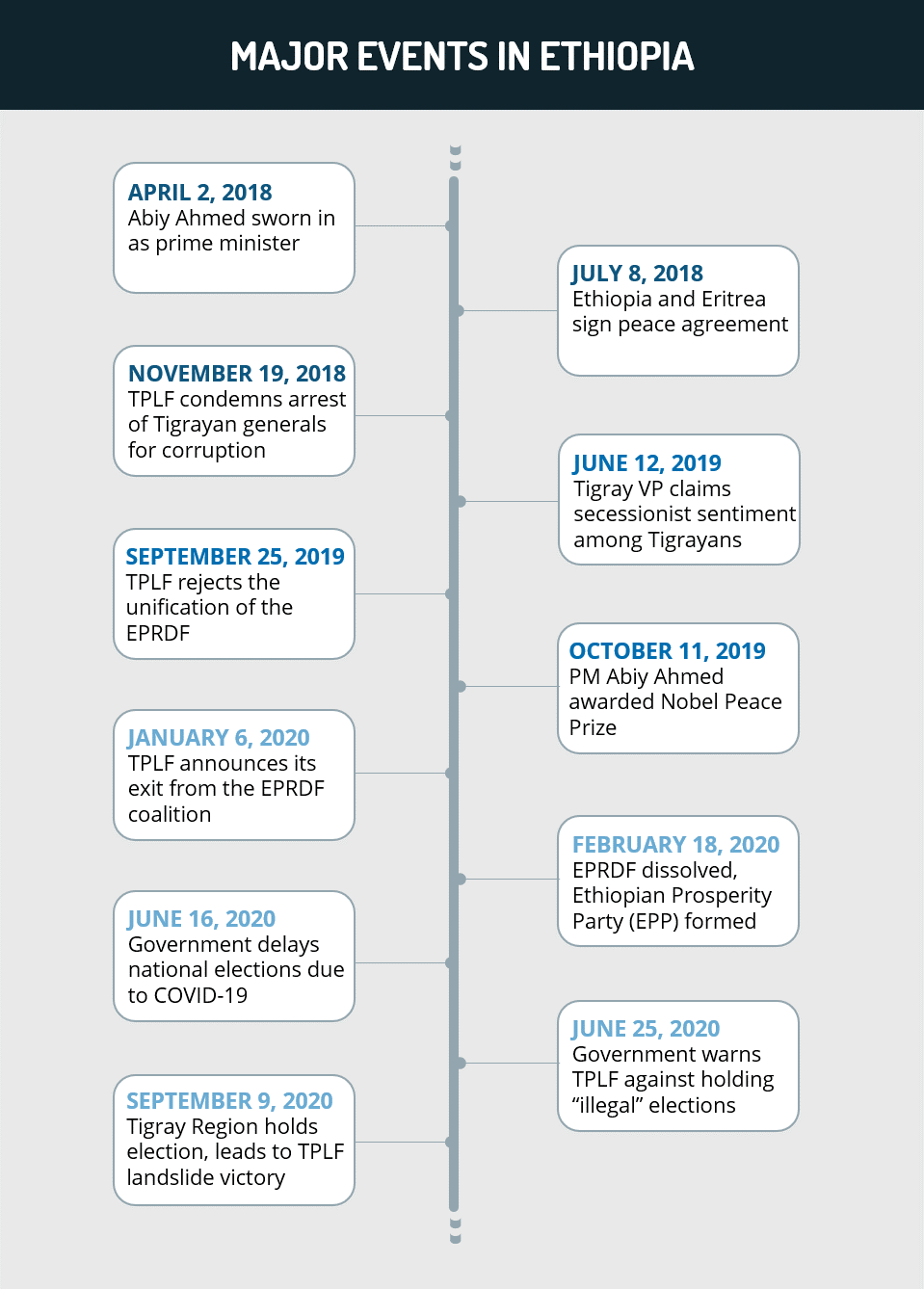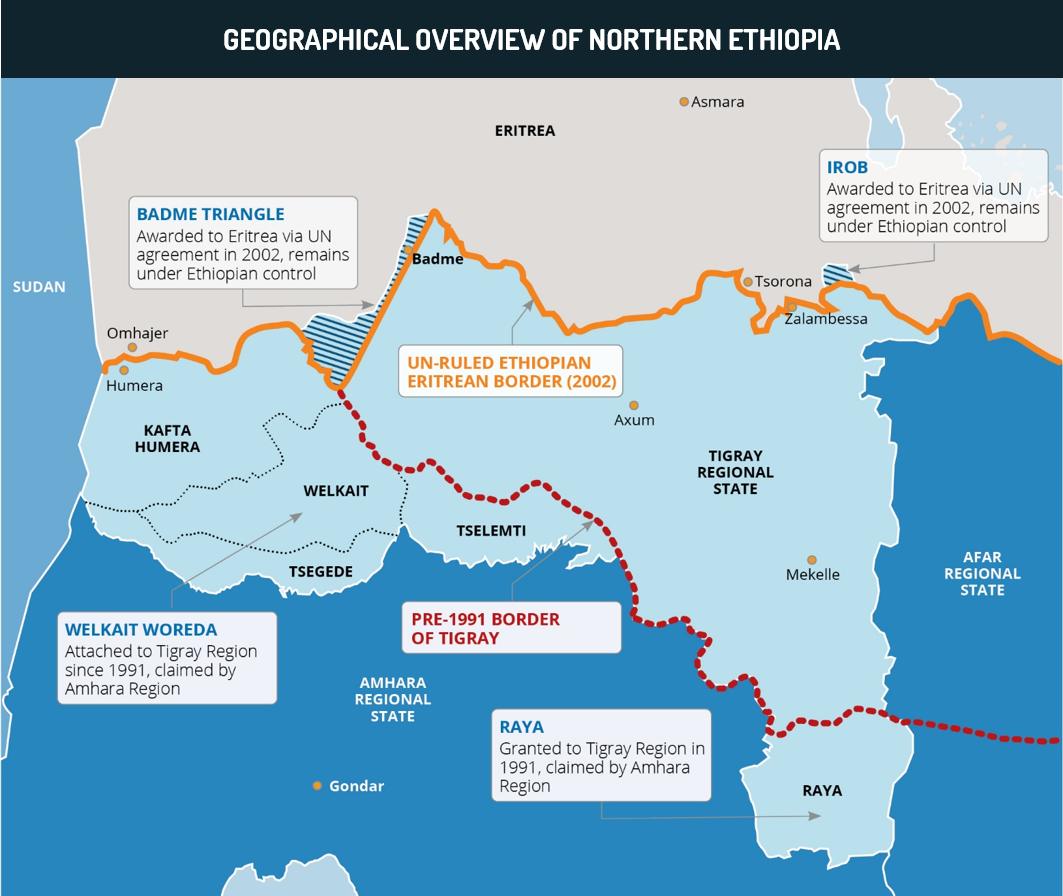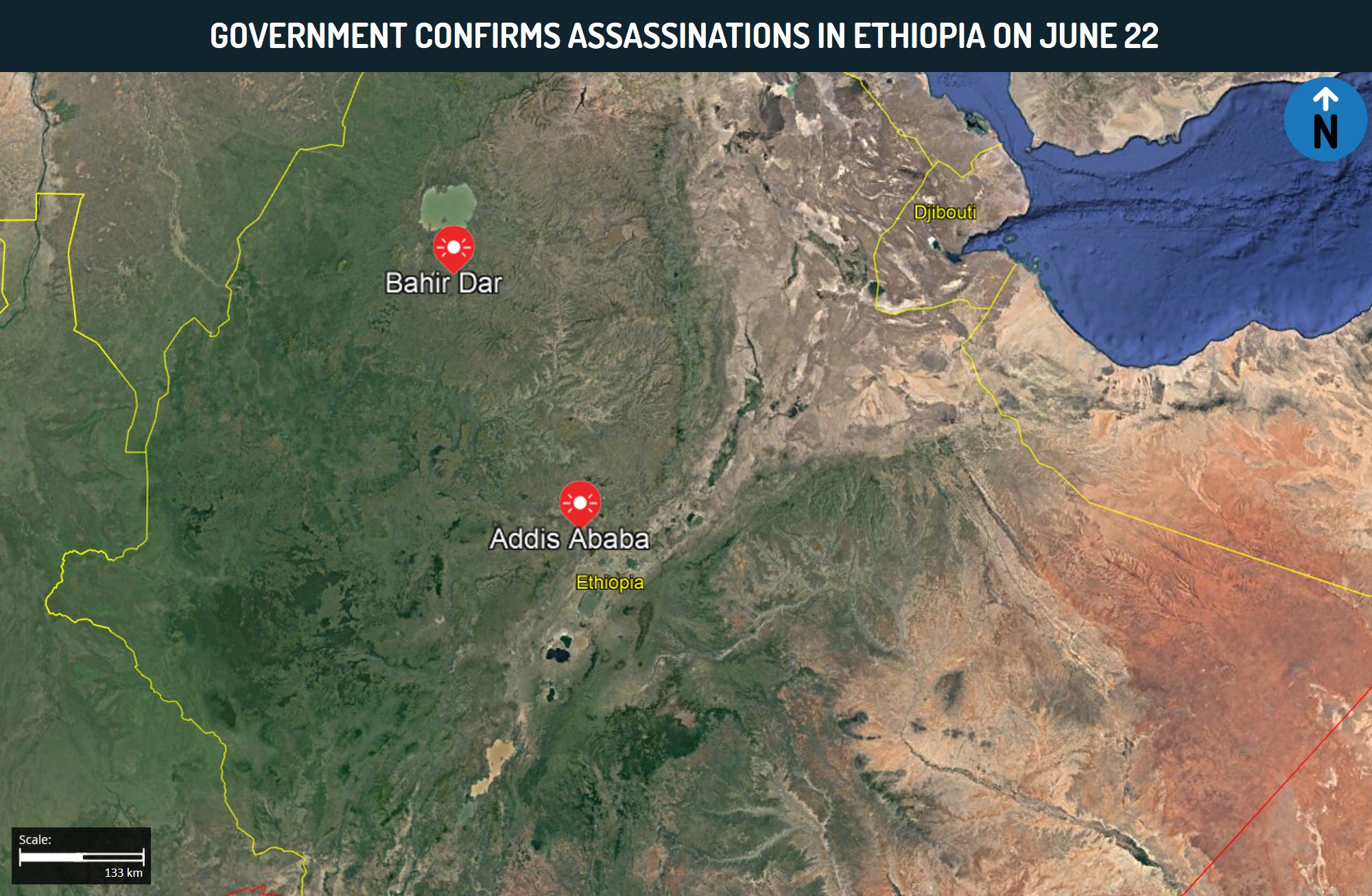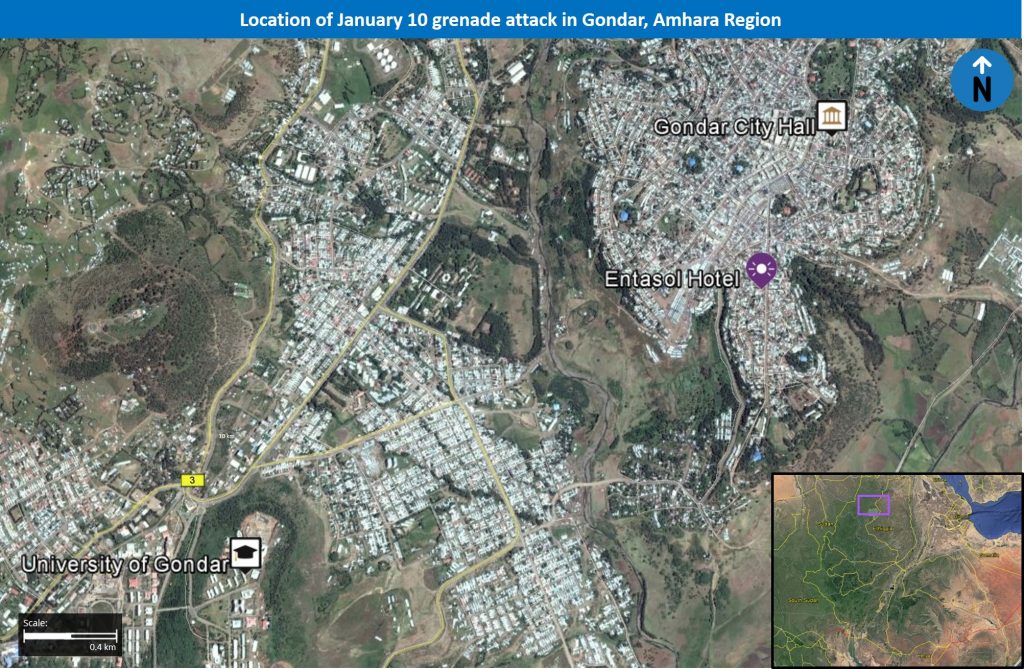Executive Summary
The ongoing military offensive against the Tigray People’s Liberation Front (TPLF) is being framed as a ‘rule of law operation’ to downplay the scale of the operation. However, given the TPLF’s entrenched position and capabilities, the conventional war is likely to devolve into a protracted insurgency.
The government’s alliance with Amhara militias particularly in disputed areas along the Amhara-Tigray border is likely to set a dangerous precedent. Given that land disputes are common across Ethiopia, the perception of tacit approval for these militias may prompt other conflicts over disputed areas.
The federal conflict with the TPLF also threatens to involve Eritrea, whose role thus far has largely been logistical or in self-defense. However, this restraint will likely be tested, particularly if the TPLF conducts further attacks on Eritrean locations or forces.
The conflict will result in a humanitarian crisis, with tens of thousands of Ethiopian refugees fleeing in Sudan. Sudan remains ill-equipped to deal with the strain on its system, heightening existing insecurity caused by arms proliferation, land disputes, and resource competition.
While the government has stated that the conflict is only against the TPLF and not ethnic Tigrayans, this nuance is likely to be lost as the conflict endures. Increased nationalistic sentiment and anti-TPLF rhetoric heighten the potential for violence against Tigray citizens.
Those operating or residing in Ethiopia over the coming days are advised to avoid all travel to Tigray Region as well as the Tigray-Amhara border region due to the ongoing conflict.
Introduction
On November 4, following months of simmering tensions, the federal government under PM Abiy Ahmed launched a military offensive that he later described as a “war” against the Tigray People’s Liberation Front (TPLF), which leads the Tigray Regional State government. The immediate trigger for the conflict was an alleged attack by the TPLF on the Northern Command of the Ethiopian National Defense Forces (ENDF) in the state capital of Mekelle and in other areas. However, tensions had become amplified after the TPLF held state elections on September 9, polls that the federal government called illegal. This appeared to escalate in late October after the federal government diverted program funds away from the state government and, at the same time, the TPLF refused to allow a newly-appointed deputy commander of the Northern Command to take his position.
Relations between PM Abiy and the TPLF have been strained since 2018 when Abiy was designated as the first ethnic Oromo PM in Ethiopia, essentially unseating the TPLF from the center of the government after they had ruled since 1991. Abiy later embarked on a raft of reforms, including the contentious dissolution of the then ruling Ethiopian People’s Revolutionary Democratic Front (EPRDF) coalition on February 4, 2019. Following this, the TPLF refused to join Abiy’s new ruling Ethiopian Prosperity Party (EPP), as the TPLF which has dominated politics in Ethiopia within the EPRDF, despite only constituting 6 percent of the population, felt increasingly marginalized. This appeared to culminate in the September 9 elections, as the TPLF regards the federal government as “illegitimate” because its constitutional mandate was supposed to end on October 5 after national polls slated for August were delayed due to the COVID-19 pandemic.
Current Situation
The House of Federation and Council of Ministers declared a six-month state of emergency in Tigray Region on November 4 and later approved the establishment of a transitional government. This followed statements by the federal government that the purpose of the operation is to disarm the TPLF and remove its leaders.
Sources citing internal UN documents indicate that the TPLF took control of the ENDF Northern Command headquarters in Mekelle and seized weapons from its armories, which partially verified the TPLF’s claims that the Northern Command defected.
TPLF leader Debretsion Gebremichael called for negotiations on November 8, though also stated that Tigray would defend itself until such time that talks take place. PM Abiy and other federal spokespeople have rejected calls for dialogue.
The TPLF repeatedly accused Eritrea of sending troops over the border to attack Tigrayan forces, which Eritrean officials have reportedly denied. Meanwhile, Sudanese officials and aid agencies have reported that over 27,000 Ethiopian refugees have crossed into Sudan, with thousands more expected in the coming days.
On November 13, the TPLF fired rockets toward the cities of Bahir Dar and Gondar in Amhara Region, causing damage to airport complexes in both cities. On November 14, the TPLF fired at least three rockets that struck Asmara, Eritrea. Both attacks were claimed by the TPLF.
As of November 18, the federal military offensive in Tigray Region has reportedly moved through western, northern, and southern Tigray toward Mekelle.
Assessments & Forecast
PM Abiy’s war against TPLF likely to result in protracted insurgency in Tigray Region
PM Abiy Ahmed gave a speech on November 8 framing the military intervention in Tigray Region as a ‘law enforcement operation’ to guarantee peace and stability and to bring the TPLF to justice, as the perpetrators of instability. By labeling the military offensive as a means to re-establish law and order, PM Abiy is likely attempting to downplay the scale of the military activity in Tigray despite not giving any timeline for the operations, along with the political and military difficulty in rooting out the TPLF from the region. This effort is further aided by the communications blackout that remains in place in Tigray and the government’s efforts to consolidate information releases into select federal sources. While PM Abiy and the federal authorities have repeatedly insisted that the ENDF has been successful “on all fronts”, the lack of independent information makes all claims difficult to corroborate.
Such corroboration is needed, as the TPLF commands a regional paramilitary force that is led by the former army generals, while also commanding militias containing war veterans of the conflict against Eritrea in 1998-2008. Furthermore, even a partial defection by the Northern Command could aid the TPLF’s defense against the ENDF offensive. The presence of significant Ethiopian military hardware in Tigray Region, intended for the defense of the country against Eritrea, has given the TPLF significant resources. This was evidenced by the use of rockets against Bahir Dar and Gondar in Amhara Region as a warning to halt the advance in Tigray.
With that said, the ENDF does appear to be moving its advance forward and pushing the front lines increasingly toward Mekelle. FORECAST: In the coming days and weeks, the ENDF is likely to continue its success in moving further into Tigray, reaching the state capital Mekelle, with the TPLF likely withdrawing from the major urban centers and engaging in guerilla tactics against federal forces. This is significant, as the TPLF is well-versed in these tactics, as witnessed by the guerilla war to topple the ‘Derg’ government in 1991. In this sense, while the ENDF may capture major urban centres in Tigray including Mekelle, the rugged terrain of the countryside and the TPLF’s experience in waging an insurgency provide a platform for a protracted and costly war. This insurgency effort is likely to be further aided by the call to all ethnic Tigrayans to defend themselves against the federal government.
Conflict with TPLF risks violence expanding southward, with fragile internal cohesion further likely to be strained
Given the specter of a prolonged insurgency against the TPLF, albeit with the ENDF controlling the major urban centers, the government will need additional troops to secure the countryside. In this context, the government is likely to revert to redeploying troops placed in other restive areas of the country such as the Southern Nations, Nationalities, and Peoples’ Region (SNNPR), and Oromia Region to the Tigray theater. This also appears to include troops recalled from Somalia, which are intended to act as a buffer against al-Shabaab militants along the border. Such actions will likely stretch ENDF capabilities, especially given that many areas of the country continue to witness ethnically driven violence. FORECAST: In this scenario, the absence of ENDF troops in other volatile regions of Ethiopia heightens the potential for attacks by ethnic militias against minorities in various states, which could then be countered by these minorities forming self-defense groups to protect their neighborhoods.
Given these conditions, the government will likely come to rely more heavily on ethnic Amhara militias to preserve the stability in the Tigray Region, especially in the disputed areas in western Tigray. The status of these disputed areas is likely to draw Amhara Region’s interest as well as represent a potential trigger for wider grievance or conflict. Amharas living in areas bordering Tigray Region claim the Welkait Woreda illegally annexed by the TPLF when it assumed power in 1991, for example. This longstanding dispute likely spurred greater Amhara involvement in the federal offensive in Tigray, with Amhara Region troops as well as local Amhara militias operating in coordination with the ENDF in its operations in these territories. These militias will likely use the targeting of Bahir Dar and Gondar to galvanize local citizens and further spur recruitment efforts against the TPLF.
However, the use of Amhara militia in apparent tandem with ENDF operations is likely to set a dangerous precedent. While it is likely that the ENDF now holds the disputed lands such as Wolkait, with other efforts ongoing to push through the Raya Woreda, also claimed by Amhara, the perception of the role of Amhara will heighten the perception of PM Abiy’s acceptance of Amhara nationalism. Such a dynamic is likely in areas such as Oromia Region, where leaders have long accused Abiy of favoring the Amhara over the Oromo. FORECAST: The perception that the federal government has allowed Amhara militias to recapture their disputed territory may embolden other states to use their own militia forces to raid and attempt to retake disputed regions. In Tigray, the TPLF will also likely use the presence of Amhara militias in disputed land to further bolster recruitment efforts against both federal and Amhara forces.
FORECAST: Given that nearly every state in Ethiopia claims land in neighboring states, this type of escalation could lead to pockets of violence across the country. If pressured by the Abiy administration to halt, other state governments may allude to the appearance that the federal government has tacitly accepted the Amhara role in Tigray, which further complicates the efforts to curb violence. Additionally, given that the stated goal of the military offensive is to remove the TPLF and install a provisional Tigray transitional government, the fact that Amhara militias have appeared to capture long sought after land is likely to act as an impediment, as the Amhara government is unlikely to allow a new Tigray government to retake these lands. This will likely raise objections among the ethnic Tigrayans, who will already be inclined to view the transitional government as false or weak and continue to support the TPLF, which has commanded strong support in the state since they came to dominate the national government in 1991 and made Tigray Region the richest and most influential state in Ethiopia.
Role of Eritrea in conflict with Tigray likely to provoke tensions within Ethiopia
Another dynamic in the war against the TPLF is the perceived and actual role of Eritrea during the conflict. The TPLF and Eritrea have been at odds with each other since Eritrea seceded from Ethiopia in 1993. Ethiopia, then led by the TPLF, fought a war with Eritrea from 1998-2000, which is said to have left 100,000 people dead. However, relations between Asmara and Addis Ababa improved considerably after PM Abiy came to power, and signed a peace deal with Eritrean President Isaias Afwerki in 2018. However, Tigrayan leaders remained highly skeptical of the peace deal, which included a promise by PM Abiy to honor a 2002 ruling on the demarcation of the border between Eritrea and Tigray, where the town of Badme was rewarded to Eritrea but remained and continues to remain under Ethiopian control.
Eritrean involvement in the conflict thus far has remained muted, with Asmara mainly acting in a defensive capacity in preventing TPLF fighters from fleeing north, as the ENDF advances northward. That said, the TPLF has accused Eritrea of shelling Tigrayan positions along the border, which both Eritrea and Ethiopia have denied. However, the Ethiopian government has made statements noting that ENDF soldiers, who were allegedly wounded in TPLF attacks, crossed the border into Eritrea before regrouping and counter-attacking. This is a sign that Eritrea is at least cooperating with Ethiopia, and is likely tacitly assisting with medical and logistical support on the frontlines. The TPLF rocket attack on Asmara was likely a response to this perceived involvement in the conflict. However, it also remains possible that the TPLF attacked Eritrea as a means to galvanize the Tigryan populace by propagating the narrative of the TPLF defending Tigray Region from both internal and external aggression.
FORECAST: In this context, it is likely that Eritrea will likely remain uninvolved in major combat operations, despite TPLF claims of PM Abiy and President Isaias working together to crush the TPLF. Asmara’s likely pragmatic stance is likely due to the fact that despite the peace deal with Ethiopia, a protracted civil war will weaken Ethiopia and increase its reliance on Eritrea in the process. Furthermore, following the 2018 peace deal, the UN lifted sanctions on Eritrea, which means that President Isaias will likely be wary of openly sending troops into active combat, and risk the reimposition of sanctions. However, given the rocket attack on Asmara, the Eritrean government’s restraint will likely be tested if further such attacks continue. In this scenario, Eritrea’s involvement in the war would further destabilize an already precarious conflict and open up another front in the fighting.
Conflict against Tigray to adversely affect Sudan with increased refugee flows, given porous frontier
Given the TPLF is unlikely to escape northward towards Eritrea, and the conflict will likely metastasize into an insurgency, TPLF elements will likely seek refuge along the border with Sudan. While Sudanese authorities closed the border on November 5, the frontier is approximately 775 km and has long been a hub for smuggling. This partially explains why the ENDF targeted western Tigray at the start of the campaign and seized airports and territory along the border, seeing this as a way to cut off TPLF escape. While these actions will likely make it more relatively difficult for the TPLF, it will be difficult to fully secure the border, particularly in the long term. FORECAST: Thus, the TPLF is likely to utilize the frontier with Sudan to procure weaponry and other supplies for their insurgency campaign against the government. While Ethiopia will likely press Sudan to increase patrolling at the border to prevent smuggling, these efforts may not be sufficient and the border will serve as some form of pressure release for the TPLF.
Furthermore, the conflict in the Tigray Region is poised to be a humanitarian disaster for both Ethiopia and Sudan. The border with Sudan will remain a gateway for fleeing civilians and potentially combatants, with Sudanese and UN authorities saying that they are preparing for approximately 100,000 refugees over the coming weeks. According to UN reports and local Sudanese sources, the majority of the crossings are occurring near Hamdayat in Kassala State, with Luqdi in Gedaref State being another major point of refugee inflows. FORECAST: The displacement will cause immense strain on Sudanese authorities who lack the resources to deal with such a massive inflow of people, in rural areas with lack of infrastructure. Further exacerbating the crisis is the fact that both Kassala and Gedaref states have witnessed intense ethnic conflicts, often over land disputes and resource competition, both internally as well as with Ethiopian farmers across the frontier. Access to land and resources are further likely to be further compromised by the refugee crisis.
PM Abiy likely to consolidate power, persecution of ethnic Tigray likely to intensify
Within days of the launch of the offensive, PM Abiy replaced his army chief and reshuffled his entire security cabinet in what the government termed as a regular change of staff. While initial reports sought to portray the replacement of the army chief as a sign of dissension within the ranks of the national security apparatus, it is notable that most of the individuals were given different responsibilities within the government hierarchy and not demoted, with few exceptions. This is likely a reflection of Abiy staffing key positions with people he regards as trustworthy and capable in handling the Tigray offensive, while also keeping the security hierarchy relatively stable. For example, Temesgen Tiruneh resigned from his post as President of Amhara Region and was appointed as the intelligence chief, likely because he is a known confidant and ally of the PM.
However, PM Abiy’s consolidation within the security establishment, with the appointment of trusted aides runs the risk of the government disregarding any dissenting voices, and concern over the effect of the war on internal cohesion. FORECAST: The government is likely to continue seeking to portray complete support for the ENDF and its operations in Tigray by organizing additional pro-government demonstrations, events, and blood drives, as has been seen across the country. However, these activities are propped up by the fact that the government has arrested some of its most strident critics, especially in the Oromia Region, where opposition politicians such as Jawar Mohammad and Eskinder Nega remain and will continue to remain imprisoned or under house arrest in the coming months. Furthermore, the government’s suppression of the press will allow the administration to portray public support for the Tigray operations, while the internet blackout in Tigray allows the government to project its battlefield successes.
FORECAST: In Addis Ababa, the government and the security agencies will likely continue with the arrests of TPLF leaders and ethnic Tigray linked to the party. Security agencies will also likely periodically publish information about raids conducted wherein the government uncovered large caches of weapons, they alleged were to be used by TPLF elements to cause insecurity in the city. However, at the time of writing, the TPLF has not demonstrated any capability to conduct large-scale attacks in Addis Ababa, the potential for disgruntled TPLF elements or supporters to conduct small-scale incidents such as the throwing or planting of grenades as witnessed on November 11, and November 14.
FORECAST: More broadly, while PM Abiy has stated that the war in Tigray was aimed specifically against the TPLF and not the ethnic Tigray, this nuance is likely to get further ignored over the coming months. Multiple reports have indicated that ethnic Tigray working within the government have been relieved of their positions, while the government has also sought to remove Tigray security officials from positions of power within regional organizations. These assessments are bolstered by the African Union’s sacking of its head of security on November 11, after a memo from the Ethiopian defense ministry questioned the ethnic Tigray officer’s loyalty to Addis Ababa. This perceived sense of persecution by the government is likely to filter through into other areas of the country, leading to a heightened potential for attacks on ethnic Tigray by majority communities. Ultimately, the conflict with the TPLF will likely herald entrenched insecurity within Ethiopia over the coming weeks and months.
Recommendations
Those operating or residing in Ethiopia over the coming days are advised to avoid all travel to Tigray Region as well as the Tigray-Amhara border region due to the ongoing conflict.
Those in Tigray Region are advised to minimize all movement. Consider contingency and evacuation plans when possible.
Travel to Addis Ababa may continue while maintaining heightened vigilance in crowded areas due to the high risks of non-violent personal property crime.
Those operating or residing in Oromia Region’s West Wollega Zone are advised to maintain heightened vigilance over the coming days and be prepared to comply with additional or sudden security measures and checkpoints.
Those operating in Ethiopia and particularly in Addis Ababa are advised to consult with us for support at [email protected] or +44 20-3540-0434.





